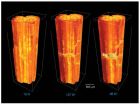The chemistry of early photographs: New American Chemical Society video
2012-12-10
(Press-News.org) WASHINGTON, Dec. 10, 2012 — The chemistry of early photography comes under the lens in a new episode of Bytesize Science, the American Chemical Society (ACS) award-winning video series. Produced by the ACS Office of Public Affairs, it is available at www.BytesizeScience.com.
The video, which features Art Kaplan, of the Getty Conservation Institute, explains that the history of photography is rich with chemical innovations and insights. Early photographers came up with hundreds of different processes to develop images in unique and often beautiful ways. Kaplan describes the development processes and distinguishing features of several types of photographs, including daguerreotypes, ambrotypes and tintypes.
Kaplan studies different styles of photographs, and the materials and the chemistry that gave life to still life in the early days of photography. To do so, he has loaded his office drawers with photographic samples and scientific instruments. Early photographs can be difficult to conserve, since each type of photograph requires a different preservation technique, he notes. And while two photos could look very similar, they may differ chemically in dramatic ways.
###
For more entertaining, informative science videos and podcasts from the ACS Office of Public Affairs, view Prized Science, Spellbound, Science Elements and Global Challenges/Chemistry Solutions.
The American Chemical Society is a nonprofit organization chartered by the U.S. Congress. With more than 164,000 members, ACS is the world's largest scientific society and a global leader in providing access to chemistry-related research through its multiple databases, peer-reviewed journals and scientific conferences. Its main offices are in Washington, D.C., and Columbus, Ohio.
To automatically receive news releases from the American Chemical Society, contact newsroom@acs.org.
Follow us: Twitter | Facebook END
ELSE PRESS RELEASES FROM THIS DATE:
2012-12-10
Advanced ceramic composites can withstand the ultrahigh operational temperatures projected for hypersonic jet and next generation gas turbine engines, but real-time analysis of the mechanical properties of these space-age materials at ultrahigh temperatures has been a challenge – until now. Researchers with the U.S. Department of Energy (DOE)'s Lawrence Berkeley National Laboratory (Berkeley Lab) have developed the first testing facility that enables CT-scanning of ceramic composites under controlled loads at ultrahigh temperatures and in real-time.
Working at Berkeley ...
2012-12-10
A newly found understanding of receptor signaling may have revealed a better way to design drugs. A study from Nationwide Children's Hospital suggests that a newly identified group of proteins, alpha arrestins, may play a role in cell signaling that is crucial to new drug development. The study appears in PLOS ONE.
More than one-third of drugs on the market work by targeting G protein-coupled receptors that control how cells communicate and function. With many hundreds of members, G protein-coupled receptors are the largest family of signaling receptors throughout the ...
2012-12-10
Infants with severe lower respiratory tract infection caused by respiratory syncytial virus (RSV) may have a dysfunctional innate immune response that relates to the severity of their disease. These are the findings from a Nationwide Children's Hospital study appearing in a recent issue of the Journal of Infectious Diseases.
RSV is the leading cause of lower respiratory tract infection in young children worldwide. The majority of children hospitalized with this condition are previously healthy with no known risk factors for serious disease. Of these infants, up to 20 ...
2012-12-10
ATLANTA – December 10, 2012—A new American Cancer Society study finds a strong inverse association between caffeinated coffee intake and oral/pharyngeal cancer mortality. The authors say people who drank more than four cups of caffeinated coffee per day were at about half the risk of death of these often fatal cancers compared to those who only occasionally or who never drank coffee. The study is published online in the American Journal of Epidemiology. The authors say more research is needed to elucidate the biologic mechanisms that could be at work.
Previous epidemiologic ...
2012-12-10
HERSHEY, Pa. -- Overweight women are not receiving proper advice on healthy weight gains or appropriate exercise levels during their pregnancies, according to Penn State College of Medicine researchers.
"Excessive weight gain during pregnancy is associated with weight retention after delivery and is a positive predictor of obesity after pregnancy," Dr. Cynthia Chuang, associate professor of medicine and public health sciences said. "Excessive gestational weight is particularly concerning for overweight and obese women given their already increased risk for pregnancy ...
2012-12-10
An analysis of sulfide ore deposits from one of the world's richest base-metal mines confirms that oxygen levels were extremely low on Earth 2.7 billion years ago, but also shows that microbes were actively feeding on sulfate in the ocean and influencing seawater chemistry during that geological time period.
The research, reported by a team of Canadian and U.S. scientists in Nature Geoscience, provides new insight into how ancient metal-ore deposits can be used to better understand the chemistry of the ancient oceans – and the early evolution of life.
Sulfate is the ...
2012-12-10
Ground-breaking research by a UCLA team of physicians and engineers demonstrates that prostate cancer can be diagnosed using image-guided targeted biopsy.
Traditionally found only by blind biopsy, a procedure that dates from the 1980s, prostate cancer now appears detectable by direct sampling of tumor spots found using Magnetic Resonance Imaging (MRI) in combination with real-time ultrasound, according to the UCLA study released Dec. 10, 2012 early online for the January 2013 issue of The Journal of Urology®.
The study indicates that the MRI and ultrasound fusion biopsy, ...
2012-12-10
New York, NY, December 10, 2012 – Diagnosis of prostate cancer remains imperfect. Current methods of prostate biopsy are limited by over detection of slow-growing tumors and under detection of clinically relevant cancers. Investigators at the University of California-Los Angeles Department of Urology have found that a new technique of targeted biopsy in a clinic setting, using local anesthesia, may improve diagnosis and aid in selecting which patients are suitable for active surveillance and which need focal therapy (noninvasive techniques for destroying small tumors within ...
2012-12-10
Renewable energy could fully power a large electric grid 99.9 percent of the time by 2030 at costs comparable to today's electricity expenses, according to new research by the University of Delaware and Delaware Technical Community College.
A well-designed combination of wind power, solar power and storage in batteries and fuel cells would nearly always exceed electricity demands while keeping costs low, the scientists found.
"These results break the conventional wisdom that renewable energy is too unreliable and expensive," said co-author Willett Kempton, professor ...
2012-12-10
Stroke the soft body of a newborn fruit fly larva ever-so-gently with a freshly plucked eyelash, and it will respond to the tickle by altering its movement—an observation that has helped scientists at the University of California, San Francisco (UCSF) uncover the molecular basis of gentle touch, one of the most fundamental but least well understood of our senses.
Our ability to sense gentle touch is known to develop early and to remain ever-present in our lives, from the first loving caresses our mothers lavish on us as newborns to the fading tingle we feel as our lives ...
LAST 30 PRESS RELEASES:
[Press-News.org] The chemistry of early photographs: New American Chemical Society video



